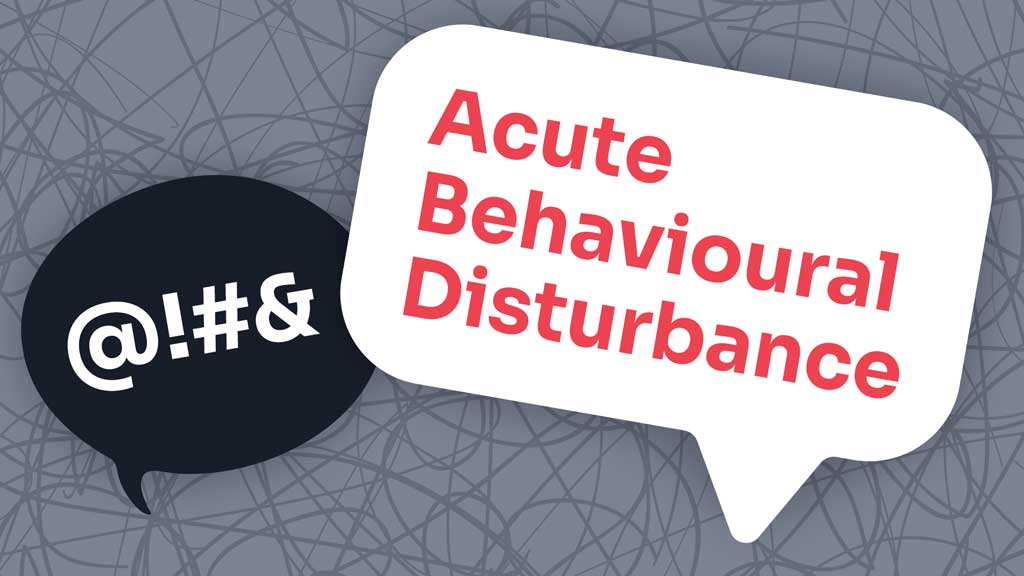Every person, including healthcare workers, deserves to feel safe in healthcare settings - but what happens if you’re caring for a person experiencing acute behavioural disturbance (ABD) who is displaying agitation or aggression? (SCV 2024; ANZCOR 2020)
What is Acute Behavioural Disturbance?
Acute behavioural disturbance (ABD) is behaviour that has the potential to cause serious harm, major injury or death to the affected person or others. It includes behaviours such as making threats, aggression, extreme distress and self-harm (ANZCOR 2020).
When encountering ABD, ensuring the safety of all people present is your immediate priority (ANZCOR 2020).
In some cases, the person displaying abnormal behaviour may not be a client, but instead, other people present such as family members or friends. There may even be situations where several people are displaying behavioural disturbance at once (ANZCOR 2020).

Causes of Acute Behavioural Disturbance
The causes of ABD vary, with some being potentially life-threatening. Determining why this behaviour is occurring is crucial in managing and treating the person (ANZCOR 2020).
Potential causes include:
- Head injury
- Hypoxia
- Infection (e.g. meningitis)
- Seizure
- Metabolic disturbance (e.g. hypoglycaemia, electrolyte imbalance)
- Organ failure
- Dementia
- Delirium
- Alcohol or drug intoxication or withdrawal
- Mental illness (e.g. schizophrenia, anxiety)
- Toxins or medicines
- Pain
- Developmental disorder (e.g. intellectual disability)
- Grief or bereavement
- Traumatic events
- Family violence
- Relationship conflicts
- Stress.
(SCV 2024; ANZCOR 2020)
Recognising Acute Behavioural Disturbance
Signs of ABD vary but may include:
- Increased arousal, demonstrated by behaviours such as restlessness, pacing, crying, wringing hands, screaming or yelling
- Appearing agitated, excited, scared or frantic
- Rigid body language, which suggests that the person is making a significant effort to control themself
- Abnormal thinking, perceptions or ideas
- Wearing inappropriate clothing for climate or context
- Altered state of consciousness
- Aggressive, violent, argumentative or strange behaviour.
(ANZCOR 2020)
Red flag indicators requiring escalation include:
- High body temperature, excessive sweating or being hot to the touch
- Insensitivity to pain
- Rapid respiratory rate and rapid pulse rate
- Extreme arousal with aggression or violence
- The first episode of ABD in a person aged 45 or over
- Abnormal vital signs
- Head injury
- Focal neurologic findings
- Decreased awareness and attention
- Known substance withdrawal or intoxication
- No clear trigger for the behaviour (in autistic people or those with intellectual disability)
- Known exposure to toxins.
(ANZCOR 2020; SCV 2024)
Two tools can assist in the identification of ABD:
- The sedation assessment tool (SAT)
- The STAMP framework of behaviours that may indicate increasing distress.
(SCV 2024)
Sedation Assessment Tool (SAT)
The SAT is used to measure distress and sedation levels by taking into account both responsiveness and speech. A score for each category is determined, and the person’s overall SAT score will be whichever of the two scores is higher (QAS 2017).
For example, a person who is highly anxious and agitated (+2) but talkative (+1) will have a SAT score of +2 (QAS 2017).
| Score | Responsiveness | Speech |
|---|---|---|
| +3 | Combative, violent, out of control | Continual loud outbursts |
| +2 | Highly anxious and agitated | Loud outbursts |
| +1 | Anxious or restless | Normal/talkative |
| 0 | Awake and calm or cooperative | Normal speech |
| -1 | Asleep but rouses if their name is called | Slurring or prominent slowing |
| -2 | Responds to physical stimulation | Few recognisable words |
| -3 | No response to stimulation | N/A |
(Adapted from SCV 2024)
STAMP Framework
The STAMP framework describes behaviours that may indicate increasing distress and the potential for behavioural escalation:
| Staring |
|
| Tone and volume of voice |
|
| Anxiety |
|
| Mumbling |
|
| Pacing |
|
(Adapted from SCV 2024)
Management of Acute Behavioural Disturbance
Remember that your immediate priority should be the safety of all people present.
General Principles
- Ensure safety and seek appropriate help or support (e.g. ambulance, security services, police)
- Reassure the person and practise active listening without judgement (if safe to do so)
- Seek further advice or assessment if required
- Perform appropriate management if the person deteriorates or loses consciousness
- Provide Basic Life Support if the person becomes unresponsive and is not breathing normally.
(ANZCOR 2020)
De-escalation Strategies

De-escalation is the use of strategies, techniques and methods to reduce agitation. This may involve communication (both verbal and non-verbal), environmental modification and working collaboratively with the person towards solutions. De-escalation works best when commenced early (SCV 2024).
When attempting to de-escalate, always treat the person with respect and empathy and consider factors such as gender identity, cultural identity, spiritual beliefs, language, trauma history, medical conditions and individual needs (SCV 2024).
If not performed properly, de-escalation strategies may exacerbate the situation. Ensure those who are attempting to de-escalate are appropriately trained in these techniques (ANZCOR 2020).
- Avoid being alone with the person, but move unnecessary bystanders and staff out of sight
- If possible, stay at least two arm lengths away from the person
- Be vigilant for signs of violence or escalation
- If possible, ensure there is access to at least two exits
- Remove objects that could be used as weapons
- If the person is in conflict with another individual, try to keep them separate
- Speak politely and allow time for communication without rushing
- Centre the conversation on the person’s needs
- Use a concerned and interested tone of voice
- Ask open questions
- Avoid shouting, raising your voice, making threats, giving orders or advice, or arguing
- Consider alternative forms of communication such as communication boards, symbols or signs
- Use non-threatening body language; avoid placing your hands on your hips or in your pockets, finger wiggling, prodding, crossing your arms or clenching your fists
- Move slowly and gently
- If possible, reduce stimuli such as noise, smells, lights and movements
- Keep the person’s cultural background in mind
- If possible, seek assistance from someone who the person knows and trusts without leaving the scene
- Ensure the person’s privacy
- Ensure the person can access food, drink, the toilet, bedding etc.
(ANZCOR 2020; SCV 2024)
If you ever feel threatened or unsafe in any way, remove yourself from the situation and seek appropriate support and assistance (ANZCOR 2020).
Verbal De-escalation
Verbal de-escalation (conversation) is the safest method of de-escalation. There are three stages of verbal de-escalation:
1. Get started
- Assess whether you need extra support or back-up
- Ensure a colleague knows where you are going
- Create a safe and helpful communication space
- Introduce yourself to the person
- Invite conversation
- Explain that you want to help the person and that you want to work together to ensure they feel safe.
2. Listen and determine the problem
- Speak clearly
- Use the person’s name
- Ask open-ended questions in order to find out what is happening
- Use simple words and short sentences
- Repeat, paraphrase and check your understanding
- Answer the person’s questions
- Clarify any misunderstandings.
3. Find solutions
- Work together and find a compromise
- Be flexible
- Offer realistic options
- Explain the reasons for rules and decisions
- Ask the person whether there is anything you can do to help them work through the issue
- Ask the person whether there is anything you can do to help them feel safe.
(SCV 2024)
Restrictive Practices
In some cases, you may need to use a restrictive practice as a last resort to prevent immediate harm to the person, yourself or others. This must only be performed after all other less-restrictive options have been attempted or considered (SCV 2024).
Restrictive practices are subject to legal requirements and obligations. Always adhere to these requirements and refer to your organisation’s policies and procedures.
Test Your Knowledge
Question 1 of 3
What is the safest and most effective method for managing acute behavioural disturbance?
Topics
Further your knowledge
 Free
Free
 Free
FreeReferences
- Australian and New Zealand Committee on Resuscitation 2020, Guideline 9.2.11 – First Aid Management of The Agitated Person, ANZCOR, viewed 3 October 2024, https://www.anzcor.org/home/new-guideline-page-2/guideline-9-2-11-first-aid-management-of-the-agitated-person/
- Queensland Ambulance Service 2017, Clinical Practice Procedures: Assessment/Sedation Assessment Tool (SAT), Queensland Government, viewed 3 October 2024, https://www.ambulance.qld.gov.au/__data/assets/pdf_file/0018/219204/cpp_sedation-assessment-tool.pdf
- Safer Care Victoria 2024, Caring for People Displaying Acute Behavioural Disturbance (ABD), Victoria State Government, viewed 3 October 2024, https://www.bettersafercare.vic.gov.au/sites/default/files/2020-04/Guidance_Acute%20behavioural%20disturbance.pdf
 New
New 
